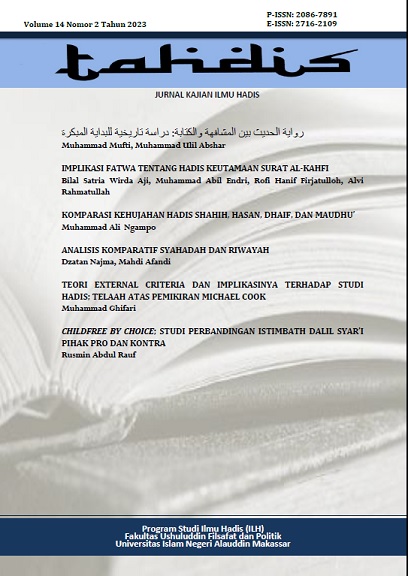Riwāyatul Hadith baina al-Mushāfahah wa al-Kitābah: Dirāsah al-Tārīkhiyyah li al-Bidāyah al-Mubakkirah
Abstrak
This article aims to discuss the method of hadith transmission in the early period, i.e., the time of the Prophet until about the second century After Hijri (AH), whether by orality or writing. The method used to write this article is descriptive with a historical approach. The main argument constructed is that since the time of the Prophet, both the oral transmission and the writing transmission have existed, but the oral transmission has dominated at the beginning of the passage. At the same time, the method of writing transmission appeared more after the time of the Companions, that is, after entering the second century AH with the emergence of various hadith codification and classification. This refutes some people who claim that the writing of hadith existed only in the time of Caliph Omar bin Abdul Aziz through the writing of Ibn Shihab al-Zuhri who died in 124/125 AH. The factors that cause the hadith transmission by oral transmission are more common in the time of the Prophet (peace and blessings of Allah be upon him) to the era of the Tābi’īn (followers), such as the main purpose of preserving the Sunnah, suggesting memorization rather than writing, as well as warning writing without the Qur'an, which is actually a special matter. The order of Caliph Umar ibn Abd al-Aziz in hadith writing is an affirmation that makes the dynamics of hadith writing grow and give birth to a new paradigm. Importantly, both oral transmission and writing are acceptable as long as they meet the criteria set by hadith experts that relate to al-taḥammul wa al-adā’ (acceptable process of receiving and conveying hadith).
Authors who publish with this journal agree to the following terms:
(1) Authors retain copyright and grant the journal right of first publication with the work simultaneously licensed under a Creative Commons Attribution License that allows others to share the work with an acknowledgment of the work's authorship and initial publication in this journal.
(2) Authors are able to enter into separate, additional contractual arrangements for the non-exclusive distribution of the journal's published version of the work (e.g., post it to an institutional repository or publish it in a book), with an acknowledgment of its initial publication in this journal.
(3) Authors should sign copyright transfer agreement when they have approved the final proofs sent by Biogenesis prior the publication.







